Sourdough has its starter. Solera has its mother. Pulque has a seed—and a story we’ve almost lost.
The day I almost ruined a buñuelo
One Friday afternoon, siblings Alejandro and Mónica Sánchez Salas gave me a ride to their hometown in Tlaxcala. I had long been curious about la semilla del pulque—the fermentation starter essential to making this centuries-old drink—and had heard snippets about it during earlier visits to their family’s ranch. Since both siblings live in Mexico City, I tagged along as they made a weekend trip to San Felipe Sultepec, just an hour and a half from the capital.
We arrived at their home around 6 p.m., greeted by their mother, Isela Islas, a renowned traditional cook who served us a delicious dinner: chard soup and chicken in a chard-based green sauce. The generous rains had brought a bounty to her garden, and her cooking was its perfect reflection. Over the meal, I had the chance to speak with her husband, Alejandro Sánchez, veterinarian, tlachiquero, and farmer, whose life has been rooted in the land and in the care of agaves and milpa systems known as metepantle.
“When you ask about the future of pulque, you’ll find people who still scrape—but very few are planting maguey,” he told me. I’d spoken to Alejandro on every visit since 2019, and this was the first time I heard a sense of weariness in his voice. “This work is expensive and I am getting tired,” he said. “Finding people to help cultivate is hard. And if you don’t use chemicals—just constantly dealing with plagues like the picudo, is tough.”
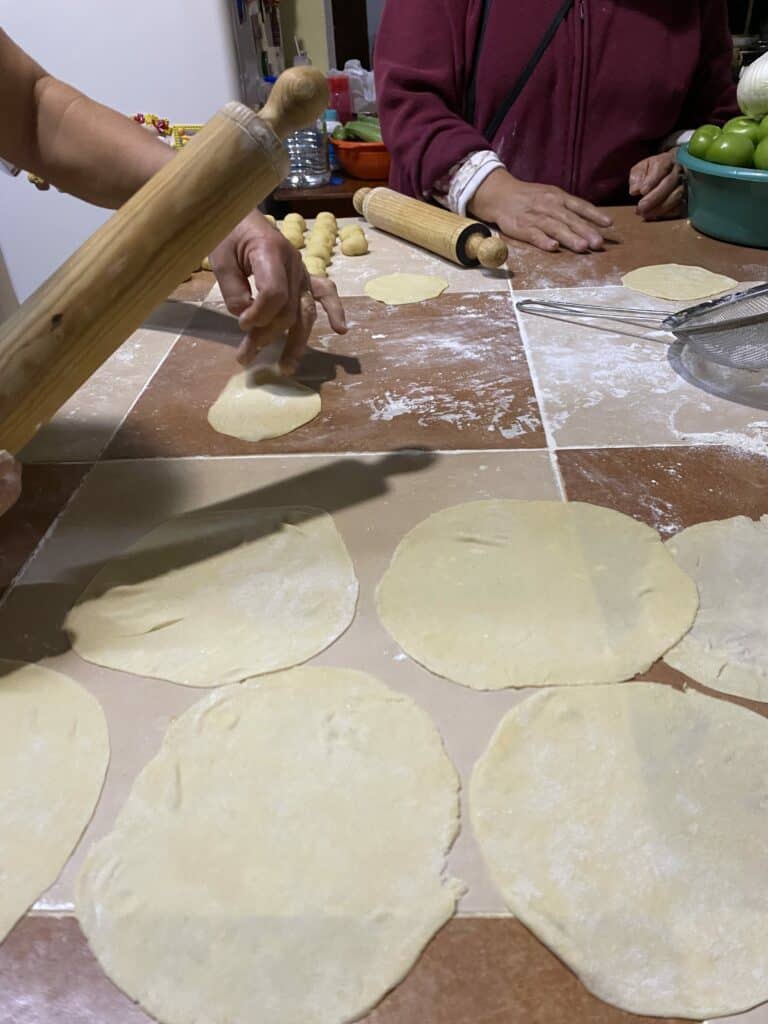
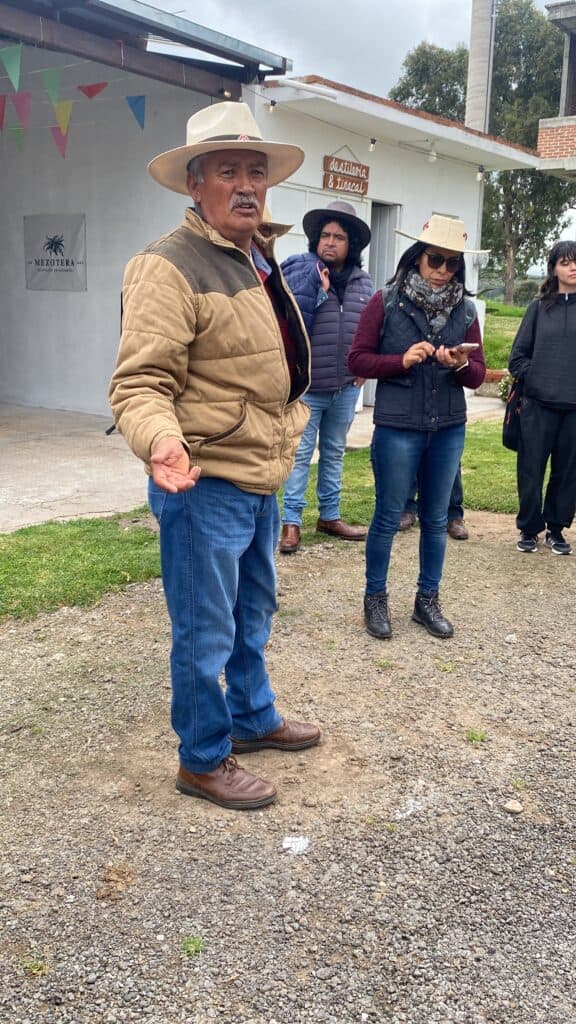
That evening, Isela was busy preparing for guests who were scheduled to visit the ranch the next morning. Wanting to help, I joined her and Mónica in packaging pinole—a toasted blue corn flour mixed with spices. Later, Isela invited me to help her and her sister-in-law make buñuelos, a local recipe she had learned from her mother-in-law. The key, she said, was in the dough: it needed just the right consistency so it wouldn’t tear when stretched.
After watching them roll and shape several perfect disks in a matter of seconds, I gave it a try. In between stories about the town, its traditions, and the looming challenges for producers like them, I began to get the hang of it. Practice, of course, makes the teacher. That night, they sent me off to sleep—and the next morning, I would meet again with her son Ale and chef Lazaro Anaya who offered to take us to find another layer to the mystery of pulque.
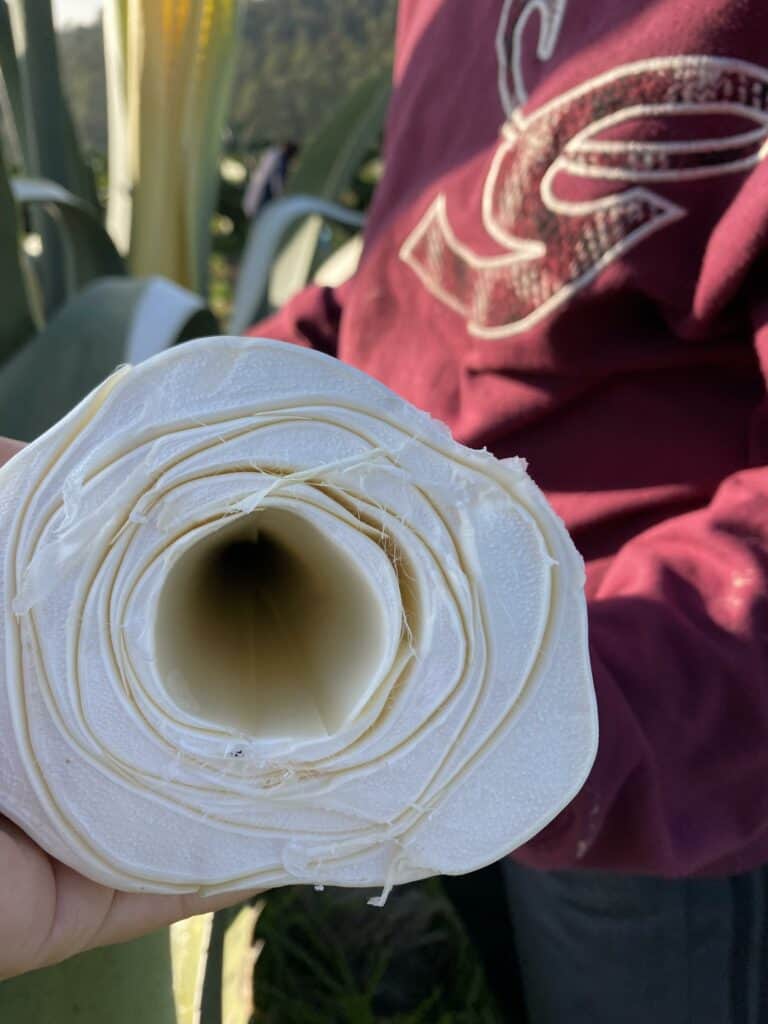
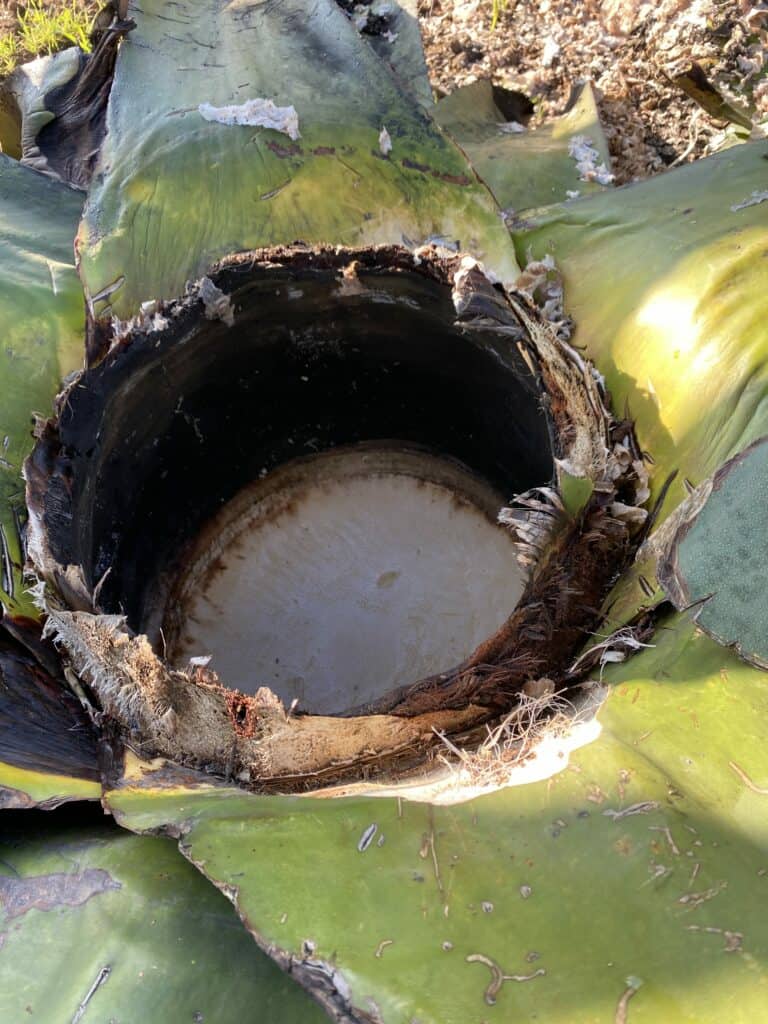
What is the semilla del pulque, or pulque seed?
Pulque is often described as a fermented agave beverage—but that barely scratches the surface. As researcher Cesar Iván Ojeda-Linares and Juan Escalona Meléndez explain in their paper Construction of a Domus: A Practice for Microbial Gathering, traditional producers known as tlachiqueros begin by selecting mature agaves and removing their shoot apical meristem—or quiote—before it begins to develop. This interrupts the plant’s reproductive cycle and redirects its energy into producing aguamiel, the sweet sap that will become pulque.
To extract it, a tool called a raspador is used to carve a cavity into the center of the agave, allowing the sap to pool. Tlachiqueros collect aguamiel twice a day, storing it in a container called a castaña, where it begins its path toward fermentation.
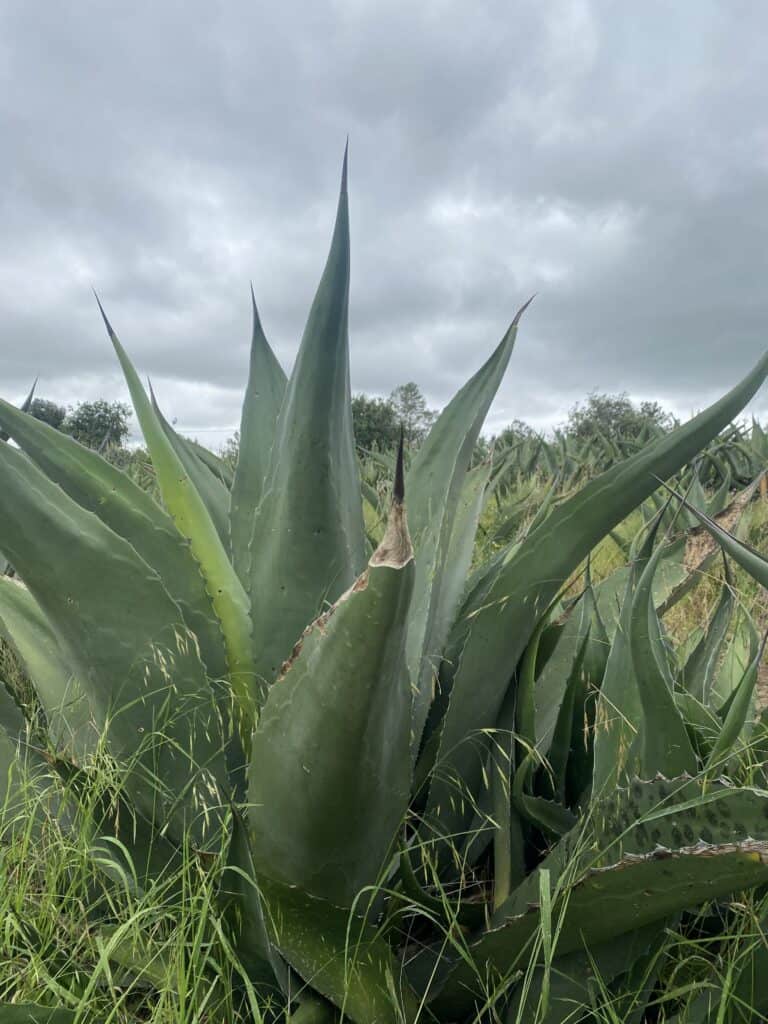
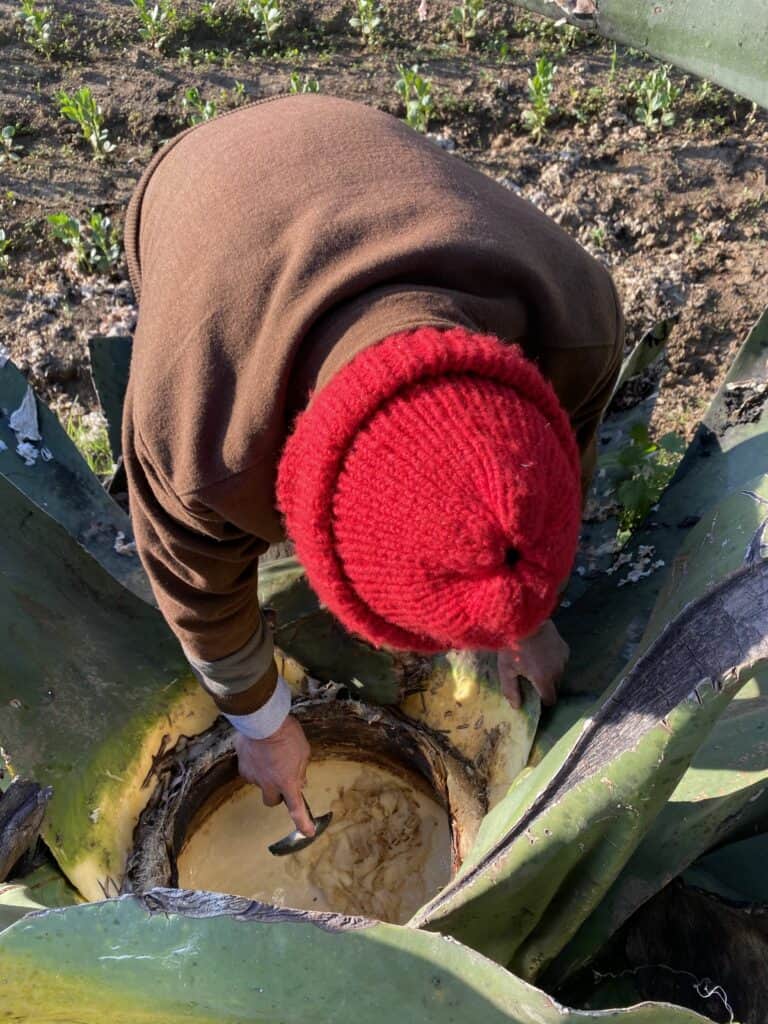
Pulque’s soul lies in a microbial heart known as semilla. It’s the fermentation starter, the seed that activates aguamiel—the sweet sap of the agave—and turns it into a living, acidic, effervescent drink.
More complex than sourdough and more volatile than yeast for wine, the semilla must be capable of fermenting hundreds or even thousands of batches. Each region, each family, typically has their own method for making it. Some include roots, raw agave fibers, or whey; others mix in fruits, nopal roots, and beans believed to hold the right bacterial load.
But there’s no universal recipe. It’s not written down. It’s passed down.
Pulque starter–A closely guarded tradition
The semilla is a recipe—sometimes personal, sometimes communal—but always guarded. Its knowledge is inherited, not acquired. Many producers only teach it to someone they trust deeply, someone who will continue making pulque, and not exploit it.
Each seed is a localized ecosystem made up of wild yeasts, lactic acid bacteria, acetic strains, and sometimes even fungi. There’s no universal recipe. Some families and even entire communities buy it from other regions. Others guard their formulas in silence. But the seed must be kept alive, fed, and used regularly—or it dies.
And even having the seed is no guarantee that pulque will continue to be made.
I once heard Alejandro say he had considered buying the seed recipe from an older tlachiquero because neither he nor his siblings had learned how to make the seed when pulque was still the main livelihood in their region. That knowledge had already been lost within the Sanchez family. In the end, it was hard to get a good deal so he had to keep buying the seed from another producer.
Now, his son—also named Alejandro, though most people call him Ale—has taken a different path: he distills pulque and exports it under the label Pal Alma. But Alejandro (the father) still worries. Even as pulque gains visibility on bar menus across Mexico, the number of people planting maguey and producing it in the traditional way isn’t growing. In fact, in states like Tlaxcala and Hidalgo, many agave fields are under pressure from larger agricultural and economic shifts.
The expansion of barley and wheat for industrial beer production has increasingly displaced maguey cultivation. And as Alejandro reminded us, plagues like picudo del agave thrive in monoculture systems, making the work of small-scale pulque producers even harder.
In Tepuente, we met Margarito García, a pulquero who had already been scraping maguey since 5 a.m. that day. He learned the craft from his grandfather—nothing written, everything passed down by repetition. His youngest son has begun to follow in his footsteps, learning to make pulque and, most crucially, to prepare the seed.
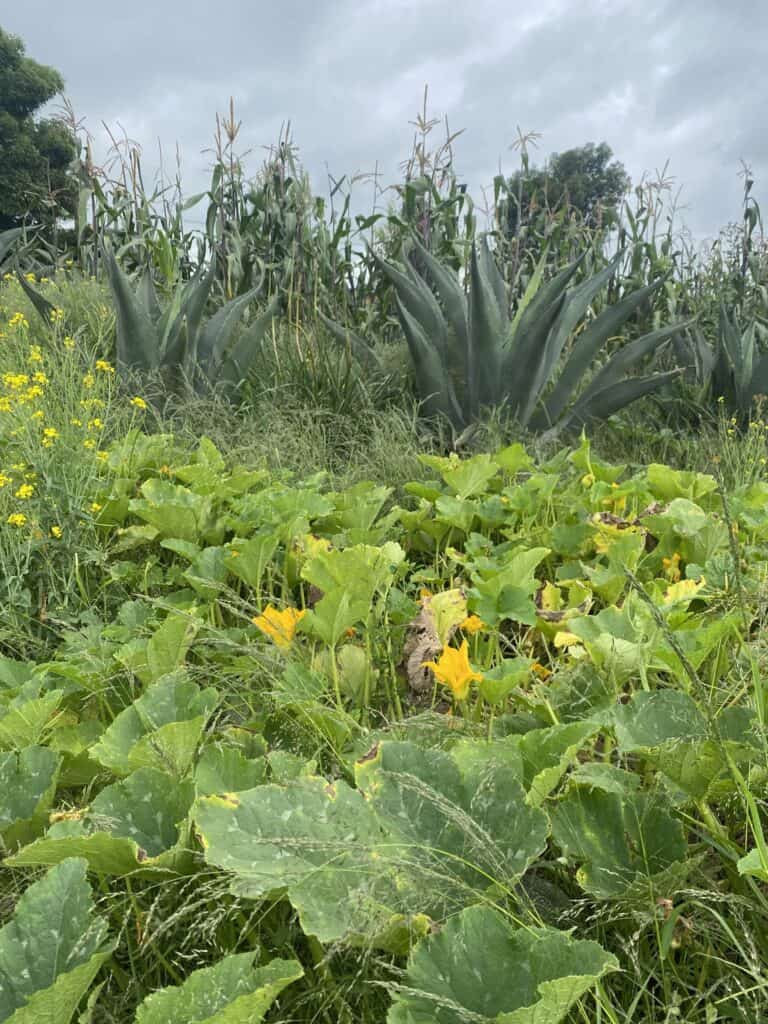
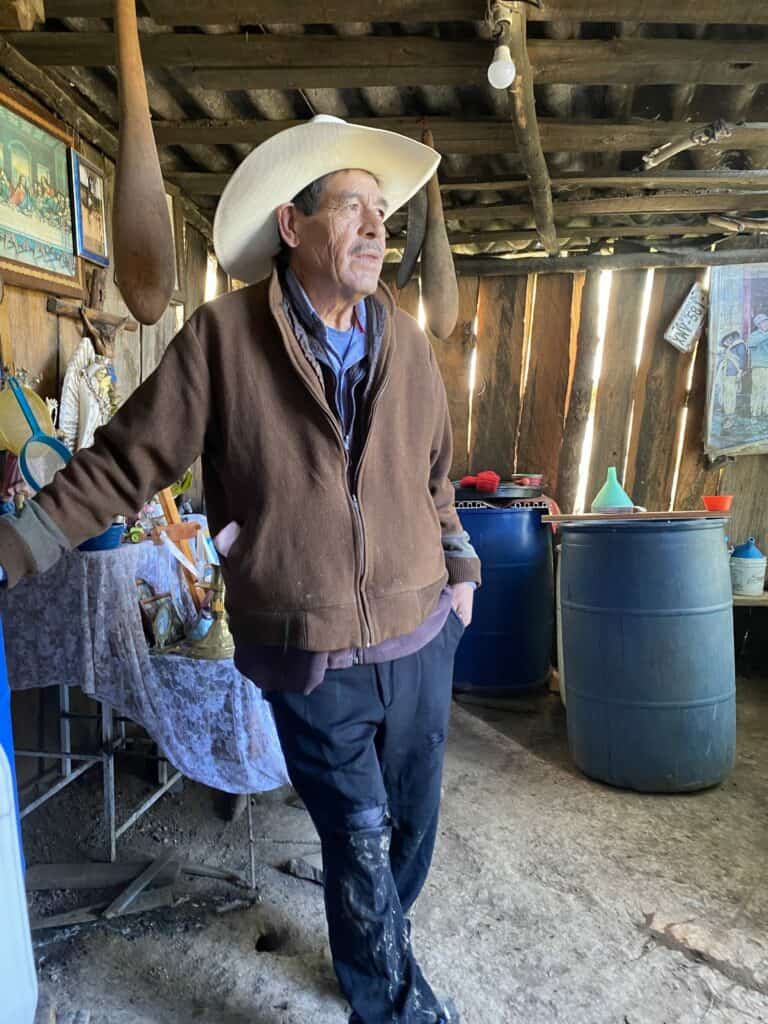
But Margarito made something else clear: knowing how to make the seed doesn’t mean you can keep the system alive. “I sold 50 magueyes to other tlachiqueros so they wouldn’t go to waste,” he told us. “This morning I scraped 14—but at least 60 more were ready.” At 70 years old he can only do so much. A few days before our visit, he had fallen off while scraping a tall maguey and hurt his leg. But he was alone and had no choice but to find a way back home to recover on his own.
And now, his main buyer has recently passed away. Until then, Margarito had been sending 450 to 500 liters of pulque per week to be sold in Mexico City.
Science, seed, and a generation’s return
Pulque isn’t static. It’s a dynamic, living system—something that Juan Escalona describes as “a biological-social organism.” A graduate in Genomics from UNAM and a trained chef with time at Pujol and Noma, Juan’s work brings the tools of science and gastronomy to study pulque’s fermentation process, its microbial life, and its cultural logic.
“The seed is a starter,” he told me. “But it’s not like commercial yeast. Each one is built from trial, error, and environmental feedback—shaped by the place, the person, and the microbes available.” There is no universal recipe. And there shouldn’t be, he argues. “Some producers add roots, whey, fruits, or soil-bound ingredients to stabilize the microbial community. These aren’t arbitrary; they’re based on generations of practice. The soil itself may contain prebiotics and bacteria that help balance the fermentation.”
But transmission happens orally—family to family. “You inherit the seed only if someone trusts you enough to carry it forward,” he says. “You can’t replicate that in a lab.” Pulque’s viability depends not only on science, but on relationships.
This belief is shared by a new generation of cultural workers and producers across pulque country—people like Enrique Taboada in Tlaxcala and Diego Contreras Huerta in Puebla. Like Juan, they didn’t inherit a tinacal, but they inherited a question: how do we keep this alive?
Enrique, who sources and distributes pulque in his region, reminds us how much the process varies:
“There’s no general recipe,” he says. “In some places, they take the best aguamiel and let it ferment over time. In others, everything is secret. In Altzayanca, there’s a community museum with an old recipe book, but it’s hard to decipher. In Nanacamilpa, people share the seed openly.”
This diversity is both a strength and a risk: the seed’s resilience depends on local practices, but it also means no single method is guaranteed to survive.
Contreras Huerta defines himself as a graphic designer by trade, tlachiquero by conviction, and researcher by passion. He leads El Bosque Pulque Puro, a project documenting the scientific and anthropological dimensions of pulque.
Researchers have identified between 200 and 300 yeast strains endemic to maguey, and about 80% of them belong to Saccharomyces cerevisiae. Still, the diversity of fermentation techniques and the interaction with the environment make each pulque unique. “Fermentation begins right there in the cajete,” explains Contreras Huerta. “It’s full of microorganisms. After scraping, we pour in a strong starter pulque and let it sit. Every night, we collect the liquid that emerges, and keep repeating that for weeks. The result is a pulque that’s deep orange, sometimes brown, and intensely fruity.”
This method is used to make pulque de perro—a robust, flavorful drink often produced near the end of the maguey’s sap cycle. The large hearts of pulquero agaves can hold up to 100 liters, allowing for an in-plant fermentation that develops complex textures and flavors over time. While in Tepuente, Chef Lázaro mentioned this was one of his favorites. The higher alcohol content gives it a distinct depth and brightness that’s hard to find in other pulques.
Diego is also vocal about the challenges: “In Puebla and Tlaxcala, few seed-keepers remain. The ones who know—don’t say. There’s talk of a book on xinaxtli or nana, but every region has its own method. There’s no single truth. And that’s what makes it precious.” Diego prefers to use the original Nahuatl terms whenever possible: octli for pulque, neutli for aguamiel, and xinaxtli for the seed. For him, these words carry the weight of history, territory, and meaning—ways of naming that reflect a worldview still rooted in practice.
Together, these voices show that pulque’s survival won’t come from romanticizing it. It will come from doing the work—planting maguey, scraping daily, and learning, again and again, how to make the seed live.
The danger of myth: pulque and the shelf of the gods
There’s a phrase that appears in almost every tourist pamphlet, blog post, or food documentary about pulque: la bebida de los dioses.
For Juan Escalona, this language—while poetic—can do more harm than good. “When we call pulque the drink of the gods, we place it on an unreachable shelf,” he says. “We admire it from afar. We worship it, but we don’t drink it. We strip it of its daily, living context.”
It’s true that the maguey—the mother plant—has long been considered sacred. It provides not just aguamiel, but food, textiles, shelter, rope, and even construction materials. Fossil records show that agaves date back nearly 30 million years, and in Mesoamerica, their domestication has been tightly linked to human activity.
But despite its sophistication, pulque continues to be undervalued, especially in urban and commercial spaces. “In Mexico,” Juan says, “we see pulque through classist eyes.” It’s long been associated with rural poverty, informality, and indigeneity. And while it’s true that in some circles this perception is shifting—that pulque is being welcomed into new spaces and conversations—it’s still not enough to undo the weight of that stigma. Pulque remains locked in a paradox: mythologized as divine, yet consumed as shame.
Changing that will take more than visibility—it will require reconfiguring the cultural and economic systems that have pushed pulque to the margins in the first place. Juan imagines a possible future where people in the urban peripheries—those whose neighborhoods have grown over what used to be maguey fields—could plant agave in their own backyards, scrape it themselves, and keep the tradition alive. It’s a hopeful vision, and one he admits is more symbolic than structural.
That’s why, Juan insists, rescuing pulque means not only saving a tradition, but rethinking the way we talk about it. Honoring the drink also means honoring the people who make it, the land that nourishes it, and the knowledge systems that sustain it. Because the truth is, tradition alone isn’t enough to sustain a system. Pulque must also be economically viable.
After closing his restaurant Coyota, Juan turned his focus toward education and research. He now runs this three-hour workshop hosted at different venues across Mexico City. The experience includes a tasting of three different pulques, a few snacks he prepares himself, and a preview of the research that will soon be published in his upcoming book. I attended one of these workshops in the middle of the rainy season. I had always assumed that this time of the year was difficult for collecting aguamiel—something I had read and heard repeatedly. But during my visit to Margarito in Tepuente, I learned otherwise.
For him, the rainy season is the most productive time of year. That morning, I watched as he scraped the cajete of each agave while his wife Paloma, followed closely behind, carrying two buckets—nearly 20 liters each—collecting the fresh sap with a jícara. By the end of the session, they had gathered over 30 liters of aguamiel.
Back at the workshop, the pulques served by Juan were balanced, expressive, and very much alive. There were three from different communities from Estado de México: one from his hometown of Zumpango, one from Huixquilucan, and one from Santa María Ajoloapan. Each one stored in a repurposed Coca-Cola plastic bottle with subtle differences in color, texture, and foam.
One was slightly sweeter, another more acidic; one had a silky body, while another was sharper on the tongue. But what fascinated me most were the bubbles. According to Escalona and researcher Andrés Ayala, a thick foam—called tiñu in Oaxaca—is traditionally considered a sign of high-quality pulque. The bubbles at the top are not random; their shape, density, and persistence can tell you a lot about the fermentation’s strength and microbial activity.
Attendees were mostly industry people with previous knowledge about ferments. A woman asked if pulque making had shared any similarities with solera fermentation systems-like those used in sherry or vinegar production—where small amounts of new liquid are gradually mixed into older batches, cultivating and sustaining a complex microbial environment. “Each fermentation carries the memory of the one before it,” Juan responded. “In that sense, pulque is a living archive.”
We often reach for European references to understand what feels unfamiliar. Huitlacoche becomes “Mexican truffle”; Xochimilco is called “the Venice of the Americas.” The intent is to relate—but we rarely stop to ask: what do we lose in translation?
The pulques on the table each had a different “head”—some airy, others dense and almost creamy. It wasn’t just a tasting. It was a sensorial lesson, grounded not in wine terminology, but in the language of the tinacal.
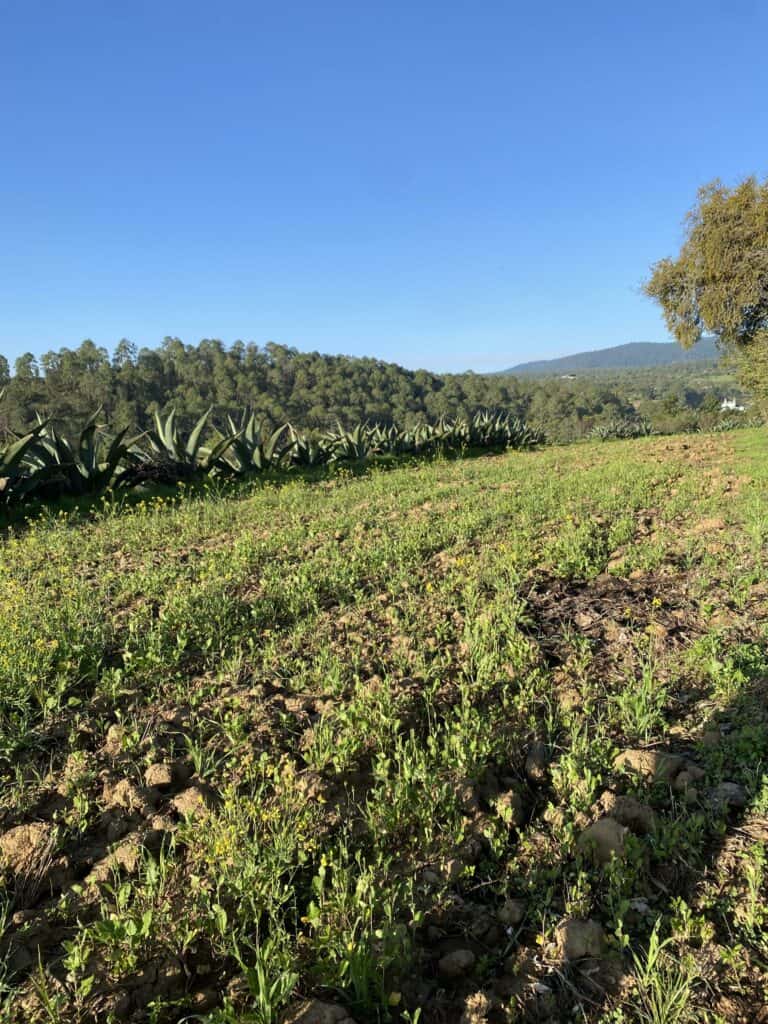
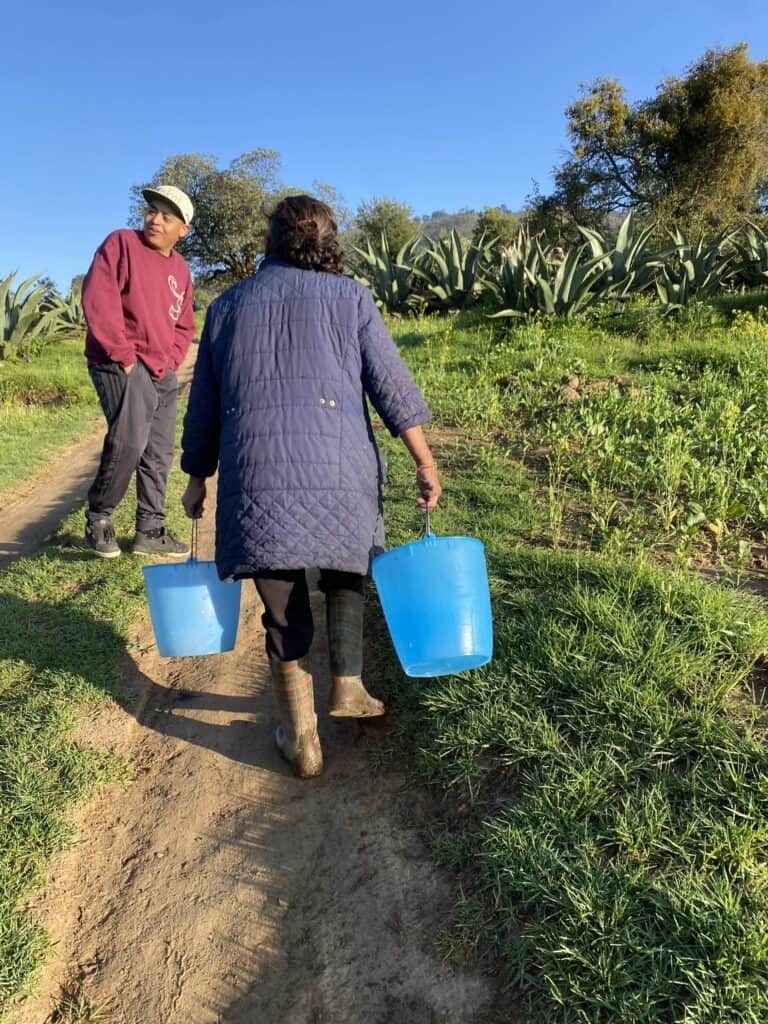

From tinacal to future
Once aguamiel is collected and inoculated with the seed, it moves into a new phase: fermentation. For that, you need a tinacal—a space where microbial life is activated, managed, and sustained over time.
A tinacal is the dedicated space—sometimes a separate room from the main house, sometimes a shaded shed—where fermentation is managed, blending is done, and microbial life is sustained.
At first glance, a tinacal might look like a shaded room or a makeshift corner with plastic barrels and wooden paddles. It lacks the aesthetic of a certified facility: there are no gloves, no hairnets, no lab coats. But that doesn’t mean there’s no hygiene.
No one wears perfume or lotion—fragrances can interfere with the fermentation. Tools are not shared indiscriminately. The cucharón used to scoop foam is not the same one used to move seed from one container to another. The rules aren’t written, but they are observed.
Once inside the tinacal, fermentation unfolds in stages—each one with a different flavor, function, and rhythm. Producers blend these stages to create their ideal profile, depending on their region, maguey, or clientele. The names vary slightly, but the general phases are:
- Semilla: The undiluted starter, full of microbial activity.
- Punta: The first phase of pulque ready to drink. Strong, direct, and sharply fermented.
- Contrapunta: A second dilution, smoother and slightly sweeter.
- Corrida: The most diluted and common version—mild, soft, and refreshing.
Is the seed common heritage or private knowledge?
Pulque is deeply territorial. The question then becomes: Who owns the right to continue this tradition? Should the seed be considered cultural heritage? Or is it something that must remain intimate, passed hand to hand, generation to generation?
What happens if those who know it stop sharing it altogether? If they pass without teaching anyone? That’s the risk. Without semilla, there is no tinacal. Without tinacal, there is no pulque.
Urban consumers drink pulque without understanding that behind each liter is not just a drink, but a relational practice—one of care, time, and trust.
The Seed as Living Memory
Pulque tradition is dying because we’ve turned it into a myth.There are fewer magueyes, fewer tlachiqueros, fewer tinacales. And the knowledge that once flowed as freely as aguamiel is now selectively shared, or lost altogether.
If we want pulque to survive, we must treat it not as divine, but as delicately human. It requires land, labor, microbial intuition—and, above all, trust.
One liter of pulque fuerte or de semilla from Margarito costs just 35 pesos. About the same—and sometimes half the price of a small drip coffee or a fancy concha in a bakery in the Roma neighborhood in CDMX. “If we were to really calculate the cost,” Diego told me, “the time, the labor, the years the plant needs to grow, the work of keeping the seed alive…the price should be much, much higher than it is now.”
But pulque is not a sweet drink. And it’s not smooth either. Its texture is one of the main reasons people turn away from it. In Mexico City, most of the pulque consumed is served as curados: mixed with fruit, cereals, or even vegetables. While curados can be delicious, they’re often made to mask texture, extend shelf life, or compensate for lower-quality base pulque.There’s also a persistent problem: the use of additives like saccharin, nopalillo, or industrial sweeteners, which degrade both the flavor and integrity of the drink. That’s why projects like those led by Juan, Diego, and Enrique focus on promoting natural pulque—so that people can learn to taste it for what it is, and recognize when it’s made with care.
But pulque is not a sweet drink. And that’s part of why it’s often misunderstood. If you’ve ever tasted it and said, “I don’t like it because it’s sour,” Remember: Not everything has to be sweet to be delicious, unique, or good for you. Sometimes, bitterness is what nourishes most.
Behind that humble liter is a plant that waited more than eight years to be harvested, six months of daily scraping, and a ferment as alive as any sourdough starter.
And even though fermentation is trending everywhere—from kombucha bars to kitchen counters—pulque remains countercultural. It resists mass production. It asks for time, patience, and relationships.
And honestly, that’s kind of beautiful.
Back to the table
Before we left Tepuente, Margarito served us breakfast: a jícara nearly a liter deep, filled with pulque de semilla. I expected something overpowering—sharp, acidic, maybe even harsh. But it was the opposite.
The first sips were mild: slightly sweet, faintly yeasty, with a texture that was smooth but carried weight. The strength only revealed itself after a few steady gulps. A ferment with body and rhythm—subtle, but assertive.
He offered us more. And we couldn’t say no. When someone offers you food or pulque, you can’t refuse.
Only later did I realize that Ale and Lázaro had estimated it at about 10% alcohol.
We had each drunk nearly two liters.
What I thought was a soft, fermented breakfast turned out to be pulque fuerte in every sense.
On the ride back to San Felipe Sultepec, we stopped again at the Sánchez Salas ranch. Monica was finishing up in the kitchen, preparing for the day’s visitors. She offered me a plate of leftover chicken from the night before, now served with black beans and fresh tortillas. I devoured it in less than ten minutes.
And then came the prize: a buñuelo, still warm, topped with concentrated aguamiel syrup.
That last bite was the perfect closing note.
The seed, the land, pulque and its people. Everything I loved that weekend wasn’t just part of a process. It was part of the identity and the life surrounding the maguey.
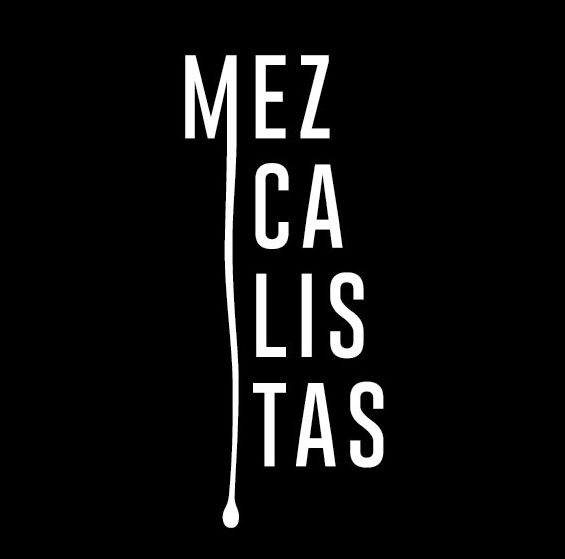

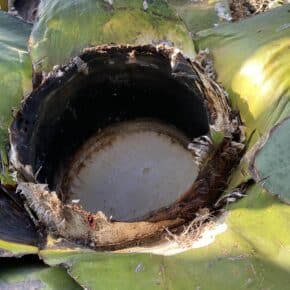
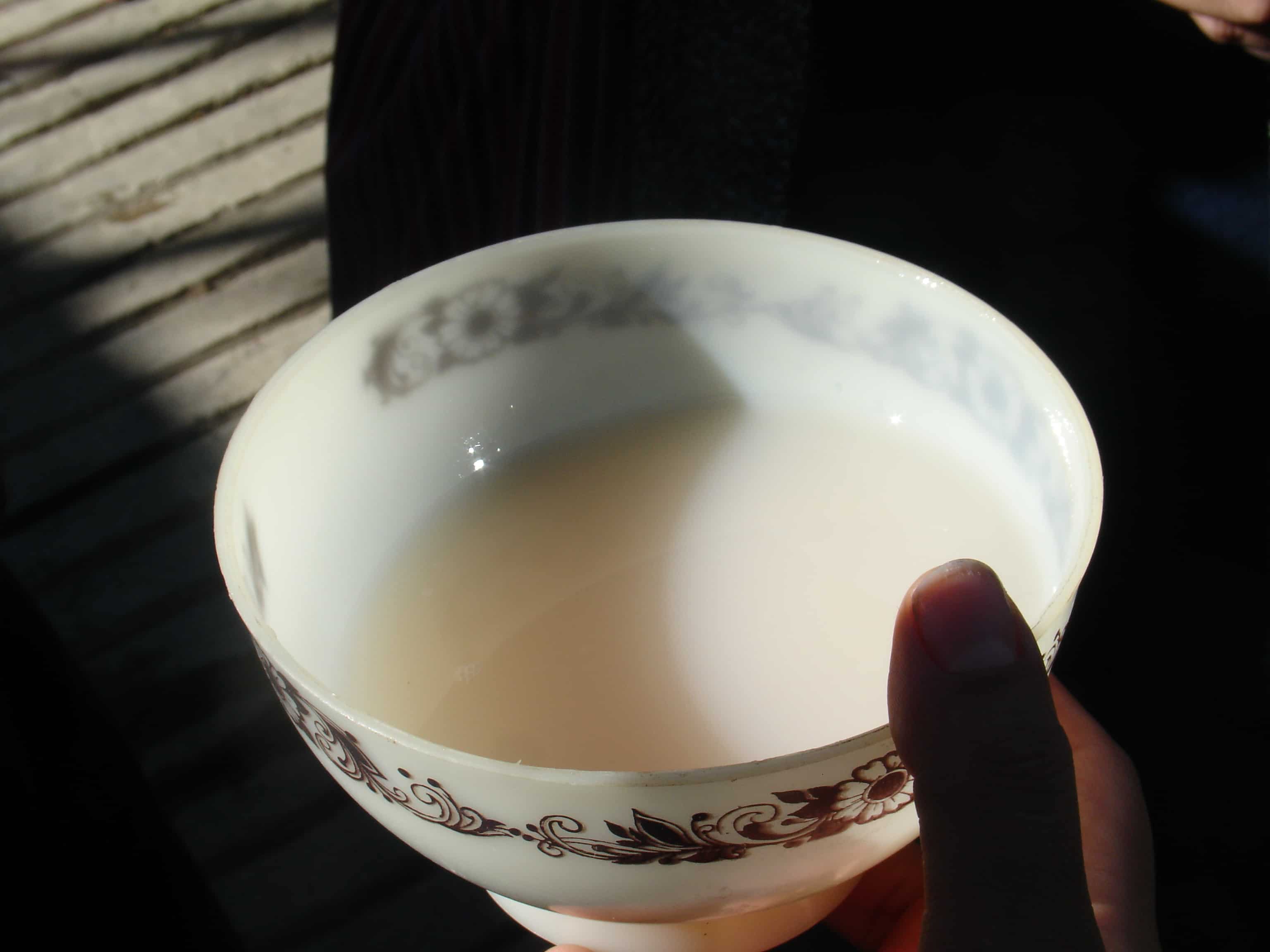
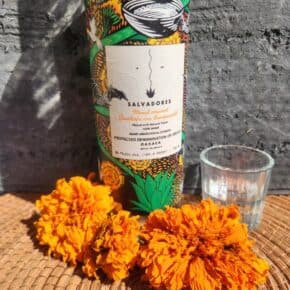
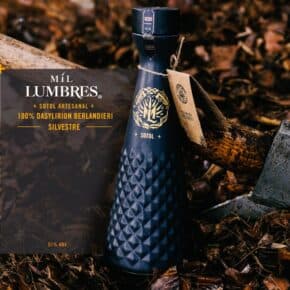
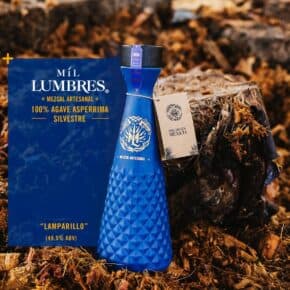

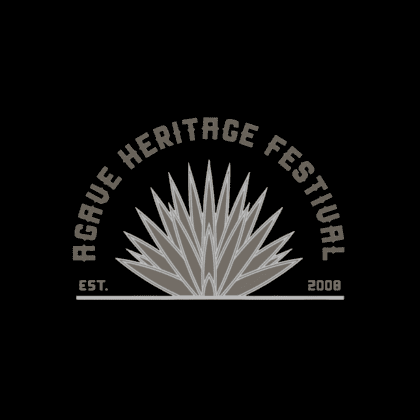



Hola amigos. Y digo amigos porque solamente gente buena se atreve a hacer tan bellos recorridos y vivir historias tan bellas como es ser invitado al seno de una familia que trabaja alrededor del pulque. Felicidades y muchas gracias por tan interesante reportaje. En Horabuena muchachos!!
P.S.- Si no es mucha molestia, compartan conmigo algún teléfono o correo electrónico al cual me pueda comunicar para hacer una visita a esas comunidades productoras de pulque. Gracias!
José – Muchisimas gracias por las palabras! So tienes interés, puedes contactar a Joahna por más información. Tambíen, ella tiene tours para visitar productores diferentes. La informacíon está aqui – https://www.mezcalistas.com/tour-item/tour-tlaxcala/. Saludos!
I have been served pulque in Mexico, freshly prepared and was told that the Aguamiel will spontaneously start fermenting while still fresh due to the warmth of the climate and tremendous number of wild yeasts and lactbacillus that are commensural with the Maguey Agave plant. There is nothing sterile about the harvesting and initial fementation. I was not aware that seed cultures were used to influence the final taste and foamy head but as a brewer, unless you boil the Aguamiel before pitching the seed culture, a highly variable fermentation is sure to resut due to microclimate and microial community variations. But maybe that is the point as that may make each batch rather unique. Think about it, each pulque batch appears to be essentially all from one unique Maguey that gives its life in exchange for its Aguamiel.
I would say the closest European tradition is related to Flemish sour beers and some traditional breweies still employ a large wild yeast catcher called a coolship to catch and introduce airborne wild yeasts into the fermenting wort. But Pulque is drunk fresh, never aged and attempts to bottle it like a beer haven’t faired very well to date. And most Flanders red beers and lambic can stand up to considerable bottle aging.
Thanks so much for that interesting perspective. Everything about this story opened up more lines of questions for me to know even more. Things seem so straightforward with production of pulque/mezcal and then you pull back one layer and before you know it you dive deeper and deeper. I am now determined to do a pulque tour the next time I am in Mexico City.
I have had a few canned and bottled pulques and they have satisfied the initial craving, but you are correct, they really need to be consumed fresh.